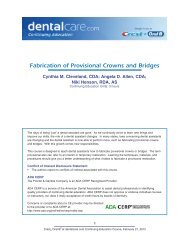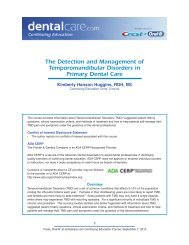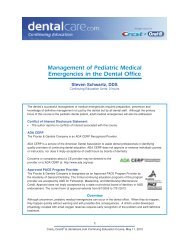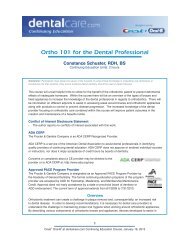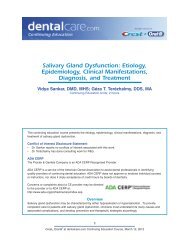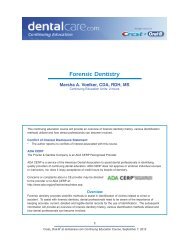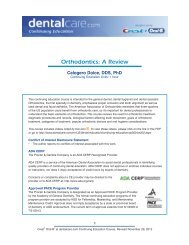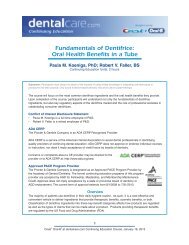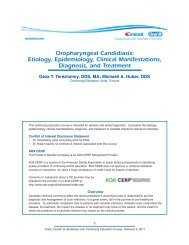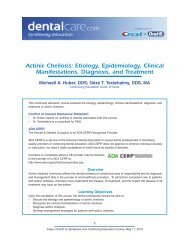CE 421 - Dental Anatomy: A Review - DentalCare.com
CE 421 - Dental Anatomy: A Review - DentalCare.com
CE 421 - Dental Anatomy: A Review - DentalCare.com
You also want an ePaper? Increase the reach of your titles
YUMPU automatically turns print PDFs into web optimized ePapers that Google loves.
Figure 16b. Permanent Teeth Arches and Quadrants. Examples of the arches<br />
and quadrants of both primary and permanent dentition.<br />
Image courtesy of Mosby’s Comprehensive <strong>Dental</strong> Assisting: A Clinical Approach.<br />
Dentitions<br />
The term dentition refers to the natural teeth in the<br />
dental arches. There are two major dentitions:<br />
primary and permanent. In children between the<br />
ages of approximately 5 and 12, each arch will<br />
contain a mixture of primary and permanent teeth.<br />
This is referred to as mixed dentition.<br />
Primary Dentition<br />
The primary dentition refers to the first twenty<br />
teeth to erupt in the oral cavity. These teeth are<br />
also called deciduous teeth, and will be exfoliated<br />
(shed) to make way for the permanent teeth.<br />
There are 20 teeth in the primary dentition, there<br />
are 2 central incisors, 2 lateral incisors, 2 canines,<br />
2 first molars, and 2 second molars in each arch.<br />
Table 1 shows the average eruption and exfoliation<br />
(shedding) dates of the primary dentition.<br />
15<br />
Permanent Dentition<br />
The permanent dentition contains 32 teeth, with<br />
each arch having 2 central incisors, 2 lateral<br />
incisors, 2 canines, 2 first premolars, 2 second<br />
premolars, 2 first molars, 2 second molars, and 2<br />
third molars. This period of dentition begins when<br />
the last primary tooth is shed. The permanent teeth<br />
that replace primary teeth are called succedaneous<br />
teeth. The permanent molars are not succedaneous<br />
teeth because they do not replace any primary<br />
teeth. The primary molars are replaced with the<br />
permanent premolars. Table 2 shows the eruption<br />
dates of the permanent dentition.<br />
D-A-Q-T System<br />
The correct sequence of words when describing a<br />
tooth is based on the D-A-Q-T system.<br />
• D stands for dentition.<br />
Crest ® Oral-B ®<br />
at dentalcare.<strong>com</strong> Continuing Education Course, April 23, 2013



